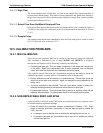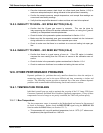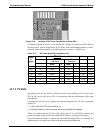
Troubleshooting & Service T400 Ozone Analyzer Operator’s Manual
256
12.4.1.3. High Flow
The most common cause of high flow is a leak in the sample flow control assembly or
between there and the pump. If no leaks or loose connections are found in the fittings or
the gas line between the orifice and the pump, rebuild the sample flow control assembly
as described in Section 12.10.1 .
12.4.1.4. Actual Flow Does Not Match Displayed Flow
If the actual flow measured does not match the displayed flow, but is within the limits of
720-880 cc/min, adjust the calibration of the flow measurement as described in Section
12.10.1.
12.4.1.5. Sample Pump
The sample pump should start immediately after the front panel power switch is turned
ON. If it does not, refer to Section 12.7.1.
12.5. CALIBRATION PROBLEMS
12.5.1. MIS-CALIBRATED
There are several symptoms that can be caused by the analyzer being mis-calibrated.
This condition is indicated by out of range SLOPEs and OFFSETs as displayed
through the test functions and is frequently caused by the following:
Contaminated span gas. This can cause a large error in the slope and a small error
in the offset. Span gas contaminated with a major interferent such as Mercury
Vapor, will cause the analyzer to be calibrated to the wrong value.
Also could be caused if the span gas concentration entered into the analyzer during the
calibration procedure is not the precise concentration value of the gas used.
Dilution calibrator not set up correctly or is malfunctioning. This will also cause the
slope, but not the zero to be incorrect. Again, the analyzer is being calibrated to the
wrong value.
Too many analyzers on the manifold. This can cause either a slope or offset error
because ambient gas with its pollutants will dilute the zero or span gas.
Contaminated zero gas. This can cause either a positive or negative offset and will
indirectly affect the slope. If contaminated with O
3
it will cause a positive offset.
12.5.2. NON-REPEATABLE ZERO AND SPAN
As stated earlier, leaks both in the T400 and in the external system are a common source
of unstable and non-repeatable readings.
Check for leaks in the pneumatic systems as described in Section 11.3.6. Don’t
forget to consider pneumatic components in the gas delivery system outside the
T400. Such as:
A change in zero air source such as ambient air leaking into zero air line, or;
A change in the span gas concentration due to zero air or ambient air leaking
into the span gas line.
06870C DCN6332


















